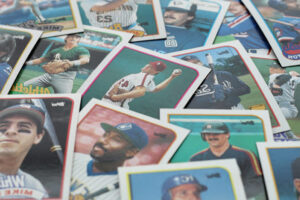According to Maine Public Radio, the sports card market is set to hit $23 billion in the next several years.
Are you holding onto rare hockey cards without knowing their true value? With the sports memorabilia market growing, certain cards can fetch thousands of dollars at auctions.
Today, we’re taking a closer look into how to spot rare hockey cards worth big money.
What Affects the Value of Rare Hockey Cards Value?
When assessing the value of a hockey card, several key factors come into play. Understanding these aspects will help you evaluate whether a card has potential value or if it’s just another common piece in your collection:
- Condition and grading
- Limited prints and special editions
- Player performance and popularity
Condition and Grading
The physical condition of a card is one of the most important aspects when determining its value. Cards that are well-preserved, with sharp edges and no visible damage, are typically worth much more.
Any creases, discoloration, or wear can decrease a card’s value. Professional grading services, like PSA and BGS, provide a standard system for evaluating condition. A high grade from these services can significantly increase the worth of a card, as collectors trust the quality assurance provided by a professional rating.
Limited Prints and Special Editions
Rarity plays a big role in a card’s value. Cards that were part of limited print runs or special editions are often more sought-after. The cards might include autographs, jersey patches, or even misprints that make them unique.
When fewer cards exist in circulation, demand tends to rise, and with it, the card’s market value. Keeping an eye out for these limited editions can help you identify worthwhile hockey cards.
Player Performance and Popularity
A player’s career achievements and popularity can also have a strong influence on card value. Cards featuring players who have made a significant impact in the sport, such as all-time greats or Hall of Fame inductees, tend to be worth more.
If a player’s career skyrockets, their rookie card or milestone moments captured on cards can become highly valuable. A card’s worth is often tied to how a player is remembered by fans and historians alike.
Identifying Valuable Cards in Your Collection
Finding valuable hockey cards in your collection can be exciting, but it requires a careful approach. There are three main ways to identify valuable cards:
- Researching card details and editions
- Looking for unique features or rare variations
- Using price guides and market trends to estimate value
Researching Card Details and Editions
The first step in identifying valuable hockey cards is to research the details of each card. Look for the year, manufacturer, and any special editions that might have been released.
Older cards, especially from the 1970s or earlier, tend to hold more value due to their rarity. Cards from reputable brands like Upper Deck, Topps, or O-Pee-Chee are often more desirable.
Doing a quick search on collector websites or databases can give you a sense of a card’s potential worth. Pay attention to details such as the year, set, and any markings that distinguish the card from others.
Looking for Unique Features or Rare Variations
Some cards stand out because of unique features or rare variations. Autographed cards, jersey patches, or misprints can dramatically increase a card’s value.
Limited-run cards, or special insert cards, often included as bonuses in packs, are also worth keeping an eye on. The variations are often produced in much smaller quantities than regular cards, which makes them more valuable to collectors. If your card has any of these special traits, it may be worth significantly more than the average hockey card.
Using Price Guides and Market Trends
Once you’ve identified a card, it’s time to assess its market value. Using price guides, such as Beckett, or online marketplaces like eBay, can help you get an idea of what similar cards are selling for.
They can show you recent sales and current listings, giving you a clear picture of a card’s potential worth. Market trends can also shift, with certain players or cards gaining or losing value depending on current events or shifts in collector interest. Keeping up with these trends will help you determine the right time to sell or hold onto a card.
Preserving and Protecting Your Valuable Cards
Once you’ve identified valuable hockey cards, preserving them properly is essential to maintaining their worth. The condition of a card can make a significant difference in its value, so proper care and storage are important.
By taking a few simple steps, you can ensure that your cards stay in excellent condition for years to come.
First, it’s a good idea to use protective sleeves or cases for individual cards. They help prevent damage from handling, dust, or accidental bending.
Top loaders, which are rigid plastic cases, offer an additional layer of protection and are commonly used by serious collectors. These sleeves and cases are affordable and can be easily found online or at card shops.
Proper storage is just as important as using protective cases. Store your cards in a dry, cool area, away from direct sunlight, which can fade the colors over time.
Heat and humidity can warp or damage cards, so keeping them in a climate-controlled environment is recommended. Many collectors store their cards in sturdy boxes designed specifically for trading cards, as these boxes help organize collections while offering some extra protection.
And consider getting your valuable cards graded. Professional grading services can seal your card in a protective case and provide a score for its condition. It not only preserves the card but also helps you prove its value when you decide to sell or trade.
Rare Hockey Card Tips
Identifying and preserving rare hockey cards can unlock the true value of your collection. With the right approach, they may hold significant worth, making them a valuable asset for any collector.
When you’re ready to sell your rare cards, head to American Legends! We’re a leading sports collectible superstore, with more than 44 years of collecting, trading, and buying rare cards.
Get in touch today to find out how to buy or sell rare hockey cards!


